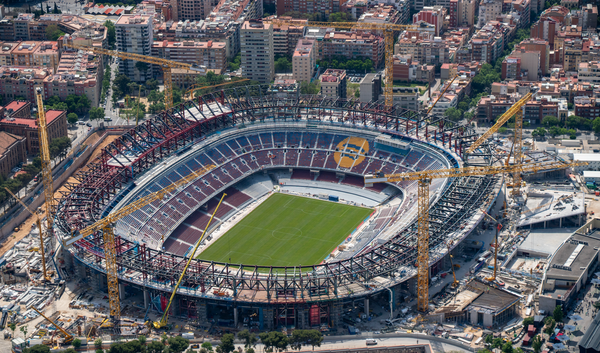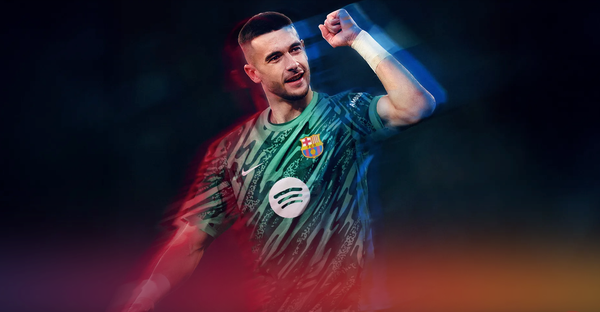İlkay Gündoğan at Barça: What's the Perfect Role for the Perfect Midfielder?
Does Xavi put the German on the left to prioritise his attacking presence or does he ensure more control by sticking him on the right instead?
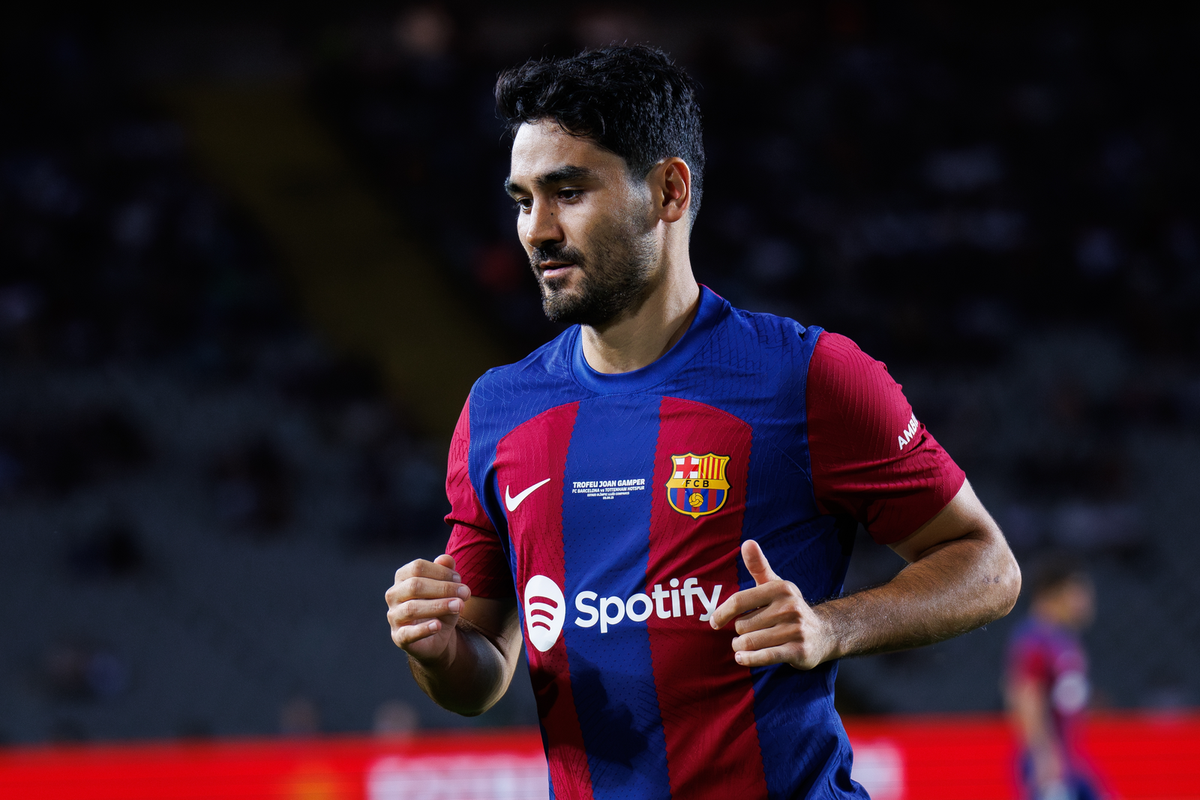
When it comes to transfers, it doesn’t get much better than İlkay Gündoğan as a free agent. Even at 32 years of age, the German is a steal for Barcelona, and, for all intents and purposes, the closest thing to a perfect midfielder if there ever was one. Gündoğan can do everything and can play everywhere; Even Pep is yet to find a role that the German can’t execute (almost) flawlessly. That should say enough about his quality.
But while Gündoğan is someone who does everything, he can’t do it all at once and in every single role. For Xavi, that means finding the most optimal way to harness very specific and very unique traits the ex-Manchester City man can offer Barcelona to help them reach new heights.
This begs the question: how does one find the perfect role for the perfect midfielder?
What’s in the box?
In spite of various different reports stemming from all corners of Catalunya, everything - from the signings, renewals, training sessions and last season’s preferences - points towards the return of the box midfield. But Barcelona’s box midfield is different from Manchester City’s so naturally, while Gündoğan may play in a similar area, his utilisation will be (at least somewhat) different.
With the lack of natural, width-holding wingers, Xavi opted for a fourth midfielder to finish the box by inverting him from the left-winger position. That role used to belong to Gavi but, again in spite of popular opinion, the youngster will find it difficult to retain that spot going forward. Why? It’s simple. While he’s a great talent, his current level is not high enough to displace neither the newcomer Gündoğan nor his peer Pedri.
But who should take his spot between these two players? Quite clearly, Gündoğan picks himself for the starting XI and immediately takes the crown for the best midfielder at Barcelona alongside the aforementioned young talisman. But Pedri is also… Pedri. And both are arguably more efficient on that infamous left side of the pitch more so than the right, even despite the fact both can and have played on the right. At first, seeing Gündoğan’s comfort practically anywhere on the pitch, I thought Pedri shouldn’t once again be relegated to the right and this would represent a golden opportunity for Xavi to put him back where he belongs - on the left. However, nothing is ever that simple. Here’s why.
It essentially boils down to both players’ skill sets and what specifically the team needs more of, particularly in relation to Gündoğan. The German can play in a variety of roles but a much more offensive role is what he’s more comfortable with.
‘One of the reasons that Xavi wanted to sign me was because of my ability to play the final pass. In crucial moments, where you have to be able to get in between the defensive lines to create chances for myself and my team-mates,’ professed the 32-year-old in a recent interview upon signing for Barcelona.
This is quite telling but it also narrows down the options heavily. Gündoğan is someone I like to call an enabler, a facilitator. Why? Regardless of where you deploy him, Gündoğan will facilitate whatever that role encompasses. Deploy him on the left side of Barcelona’s box system and he takes the Gavi role to new heights, facilitating the Catalans’ box presence. Deploy him on the right and he facilitates control like the best of deep-lying midfielders. In other words, Gündoğan is a midfielder made in a lab.
Of course, there is scope to deploy him in a double or even a single pivot as well but Barcelona have both Frenkie de Jong and Oriol Romeu there already. Besides, the deeper he’s deployed, the more of his uniqueness specific to Barça you lose. So that leaves us only with two real options: left-sided #8 or right-sided #8? Attack or control? Positional freedom or (more) positional discipline?
Let’s dig in.
Barça’s LCM vs Barça’s RCM
We know Gündoğan’s profile is vast; he’s complete in almost every technical category from control, passing, shooting and awareness all the way to the more niche aspects like box-crashing, movement from deep and goal-scoring. However, a profile is not the same as a role in a team. Just like Gavi’s role differs from Pedri’s, so too would Gündoğan’s role change depending on which spot he takes.
So what are the differences between Barcelona’s right-sided #8 and left-sided #8? For much of the 2022/23 season, Xavi’s team focused on the overload-to-isolate tactic. To put it simply, you put a lot of players on one side of the pitch, inviting the opposition defenders to follow you, and in that way rid the opposite side of heavy marking. For Barça, the left side was the combinatory, overloaded side and the right was where the isolated wingers would wait for the perfect switch that sends them into open space.
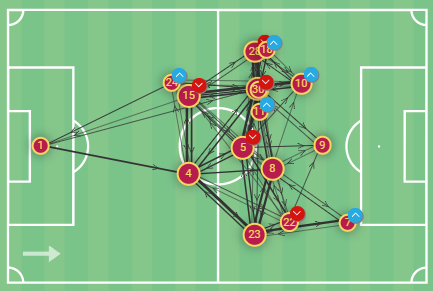
Here is a very simple and very telling example: the left is overloaded with a lot of players while on the right, Ousmane Dembélé is isolated and attacks space. Interestingly, however, the effect Xavi’s box midfield has on the interiors (high midfielders, #8s) themselves is (often, not always) quite the opposite. The left-sided interior is the higher-positioned one; often attacking space and crashing the box. The right-sided one is the opposite; often deeper-positioned, more build-up oriented and with more volume on the ball.
If we compare Gavi and Pedri, for example, the latter regularly tallies more time on the ball, receives and deploys more passes per 90 and is a more prominent progressor of the two. Of course, part of it is also Pedri’s sheer brilliance but it’s also the role that drags him deeper and turns him into more of a controller. That’s not to say Pedri is always deep; he isn’t. But Gavi is the midfielder with the highest number of touches in the box, even though the expected goals and assists often don’t translate equally well. This is the role forcing him into such positions while his profile limits the final product.
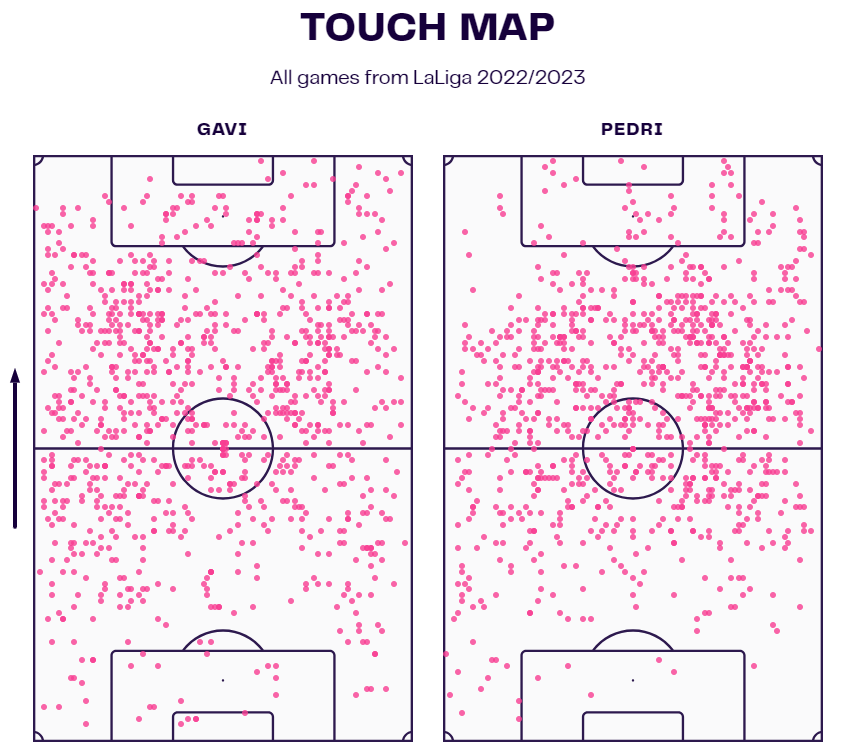
Pedri also has more volume so the sample is bigger. However, we can see that even with fewer overall actions, Gavi has a more prominent box presence (high touches) while Pedri has a more meaningful build-up role (deep touches). This reflects their roles in Barcelona’s system.
Generally, looking at the team’s touch map and passing maps below, we can conclude a similar thing. Note, however, that this is not exclusive to midfielders’ touches nor is it exclusive to Pedri’s and Gavi’s; this is the whole team taken into account. Also, a point to consider is the focus on the involvement of an inverting right-winger like Dembélé as well as the lack of such a winger presence on the left.
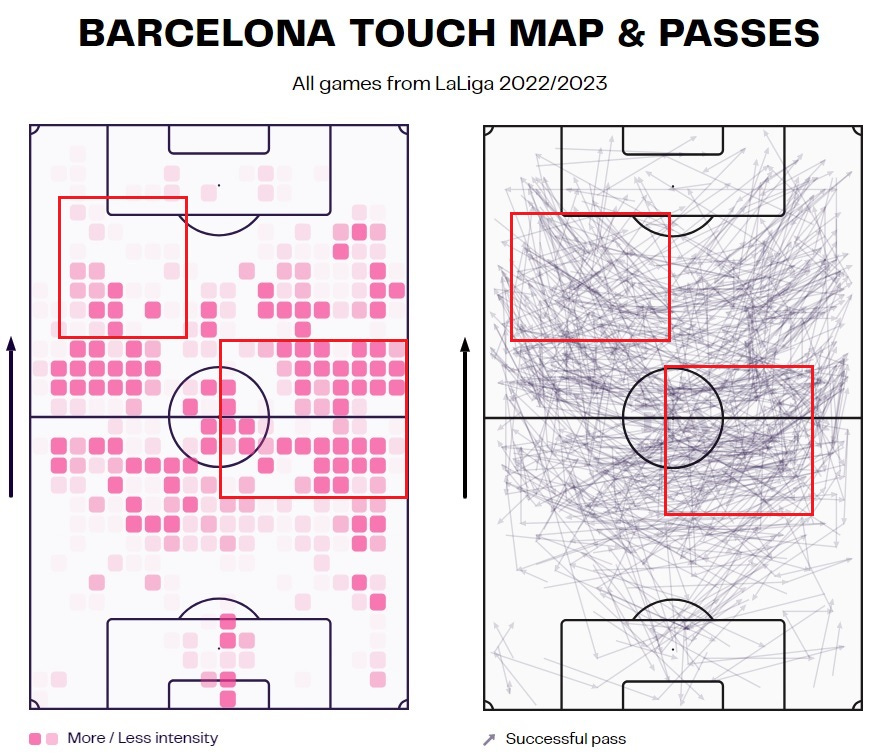
Even with that factored in, we can see certain clusters forming on the opposite ends of the maps - a high presence on the left without a winger and a bigger presence deeper on the right. This isn’t a strict rule and Xavi allows for variation and freedom. However, it’s roughly the setup that’s to be expected. A similar thing can be discerned from Barcelona’s shot assists and progressive passes.
Again, considering Dembélé and Raphinha are the team’s best creators and both often occupy the right, a big number of those passes are indeed theirs. In fact, the two are top two or top three in all of: assists per 90, expected assists per 90, crosses from the right flank, crosses to goalie box per 90, passes to penalty area per 90 and deep completions per 90.
On the left, however, the brunt of the creation falls down to Jordi Alba, who’s now gone, and then Alejandro Balde, Frenkie de Jong and Gavi.
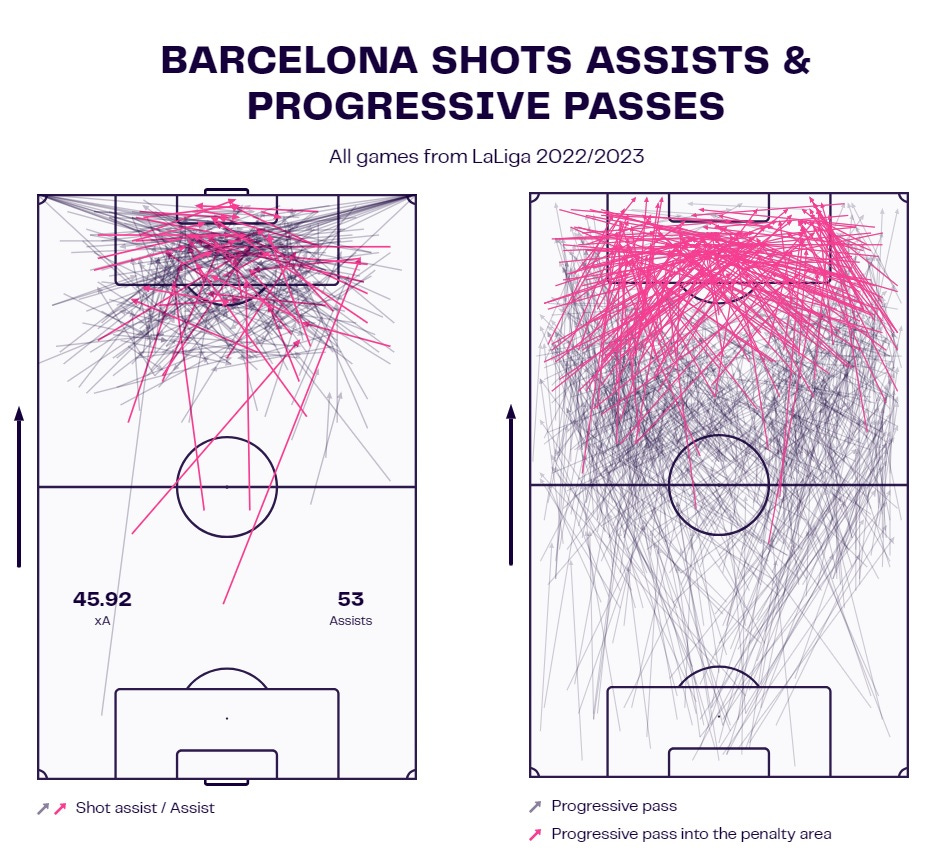
When it comes to attacking duels per 90 and touches in the box per 90, Gavi tops the categories. Pedri, however, tallies 0.02 more shots per 90 and 0.05 more expected goals per 90, which is impressive in its own right, especially considering their roles. One would assume he’d potentially eclipse Gavi’s contribution on the left too, if he were given a chance to do so.
So now we know what to roughly expect from the left-sided midfielder and what from the right-sided midfielder. But how does the perfect midfielder factor into all of that?
The Gündoğan dilemma
We know that at Manchester City, Gündoğan is used to playing in the left half-space, completing Guardiola’s box of Rodri - John Stones, Gündoğan - Kevin De Bruyne. While the nature of Xavi’s box is somewhat different, the functionality of the left interior remains (mostly) the same. But should Gündoğan get that role at Barcelona over someone like Pedri?
Initially, I had said no. Pedri is the most influential player in Xavi’s system and optimising what he does on the pitch is what would inevitably benefit the whole team the most. But what is the difference between having Pedri operate in the ‘Gavi role’ vs Gündoğan doing the same? Well, it’s all about deciding which player you want closer to the box and which one more involved in the build-up.
A left interior should have access to the first and second phases of the game, especially one of Pedri’s quality. Gündoğan had that at Manchester City due to Jack Grealish’s presence just outside of him but here, he won’t. Not as much anyway. We already saw earlier the inverted left-winger role limits the involvement of the player altogether, as evidenced in Gavi’s comparatively low touches volume. Pedri is too good to be limited by any stretch of the imagination. Of course, so is Gündoğan but he is also more proficient in the specific things the role would require of him.
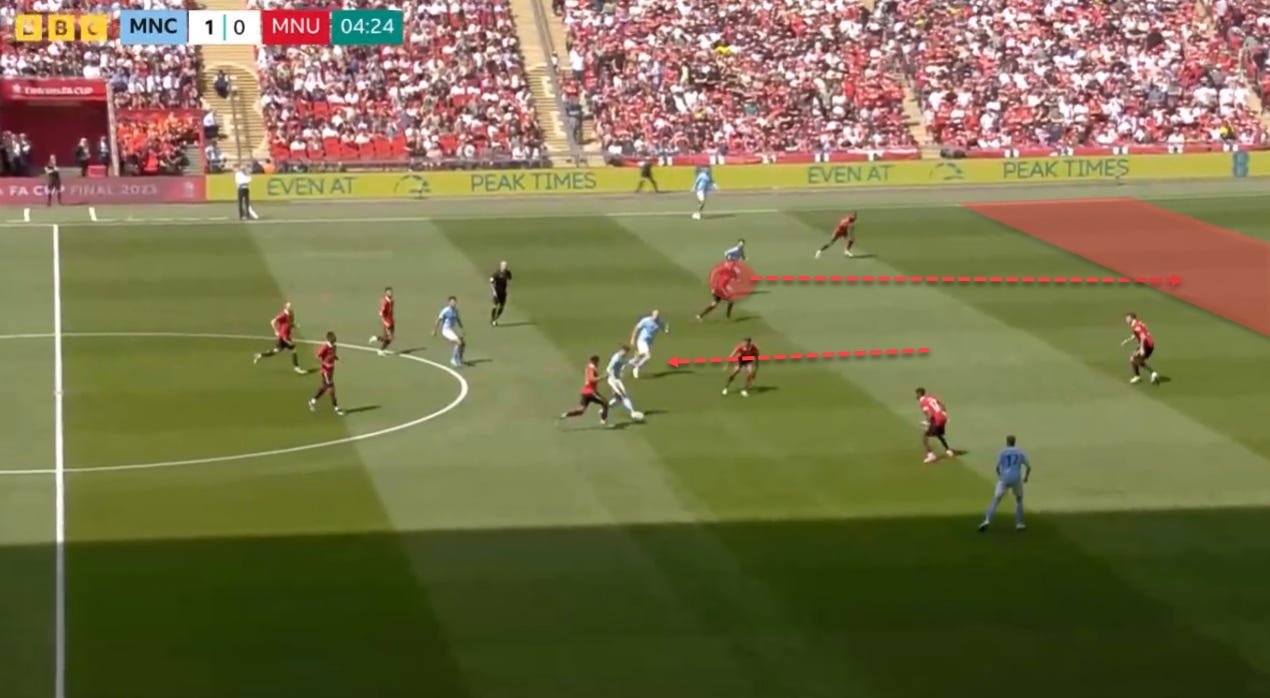
In a very basic sense, just being someone who is excellent at recognising the space and being able to attack it is a great thing. It’s not something Pedri can’t do but it’s something he doesn’t specialise in, nor would it be the optimal thing considering what he does specialise in. Xavi, however, loves for his midfielders to be this aggressive off the ball; it’s why we’ve seen him turn to the likes of Franck Kessié and also why Gavi is often seen as an outlet of sorts.
While these two couldn’t encapsulate the role fully, Gündoğan will through his mastery of space and movement. With Gavi also being the most aggressively-positioned midfielder at Barça, tallying the most touches in the box, offensive duels and just missing out on the top spot for shots per 90, it’s fair to assume a similar thing may be asked of Gündoğan.
Fortunately, the German is quite efficient at all of this. Compared to Gavi, Pedri and De Jong, Gündoğan tallies more total expected goals, more xG per 90, more shots per 90 and more touches in the box per 90. All while also registering comparable creative on-the-ball supply, which could increase in a less intense league compared to the English top flight.
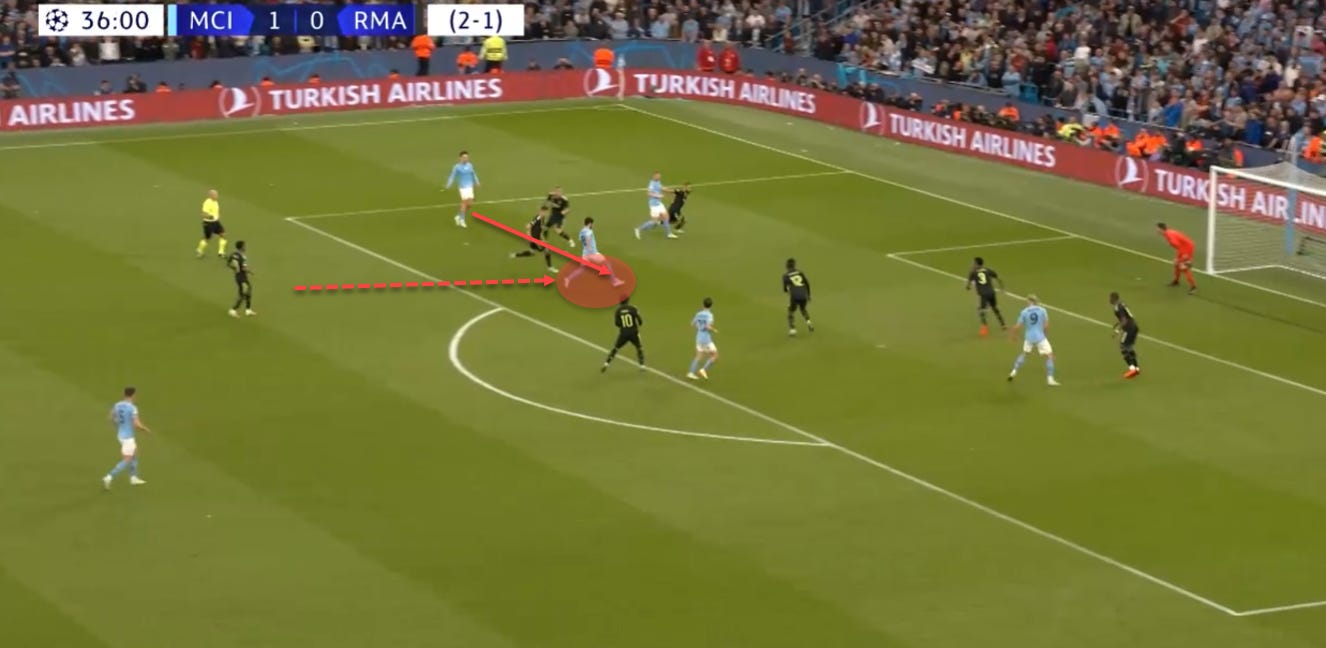
But it’s that box presence of the Gavi role that Gündoğan can elevate the most. He will make the runs from deep, arriving in the small pockets of space, and be in the right place at the right time. Timing, awareness and the ability to finish. This is the unique aspect he brings to Barça no one else bar the forwards do.
Besides, that’s what he wants to be doing too. We go back to his interview from the beginning of the analysis where he says he wants to be the difference-maker higher up the pitch; that’s the essence of Gündoğan. It’s not that he can’t or won’t do anything else but Pedri can be the controller and replicate the German’s deep influence. But he can’t replicate his high influence — yet.
Here, for instance, Gündoğan’s role and natural tendencies take him straight into the box, awaiting the cross and ultimately scoring the goal.
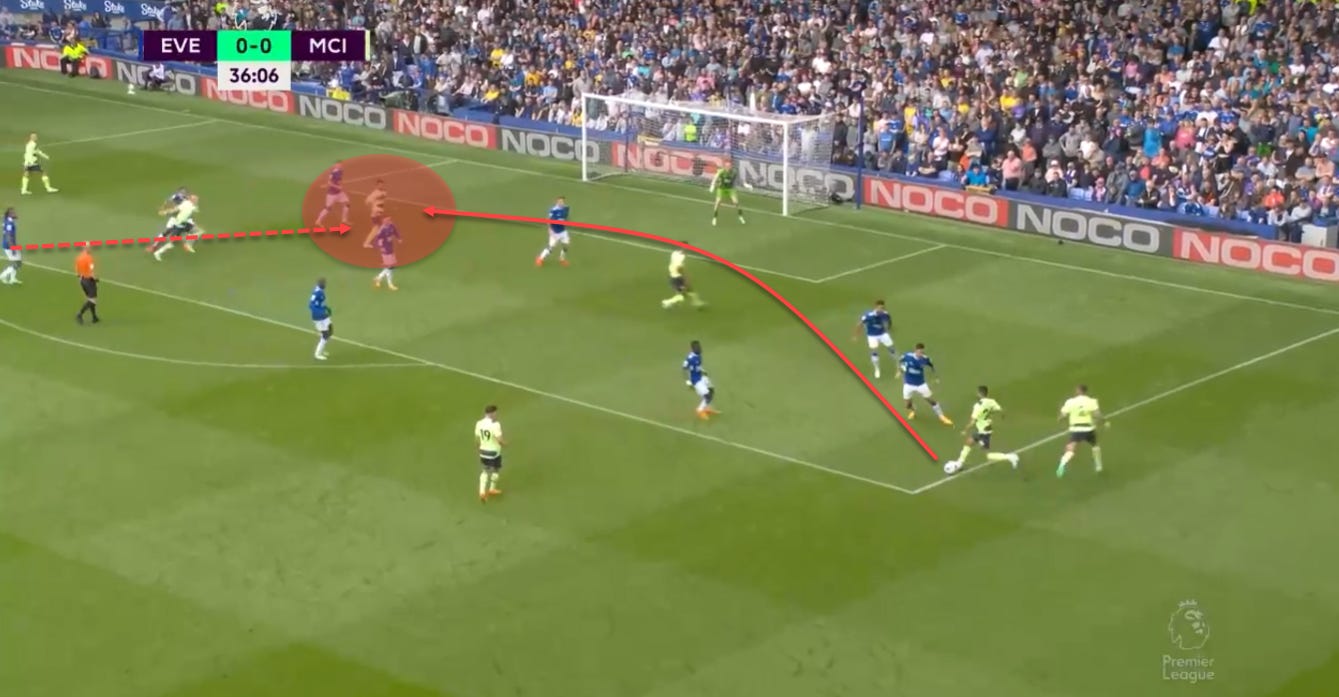
It’s that kind of bite to his profile Xavi will appreciate most, especially with the lack of a reliable threat coming down the left side of the pitch. While Pedri is still polishing that side of his game and there’s no doubt in my mind he can and will get there soon, Gündoğan is already there. And Xavi is no stranger to picking things that benefit him right here and right now over something that’s still a young project.
Considering Gündoğan scored eight goals with 48 shots, registering 5.78 xG in the process, good enough for 0.12 xG per shot, it does show more proficiency in that area than any of the other midfielders at Xavi’s disposal.
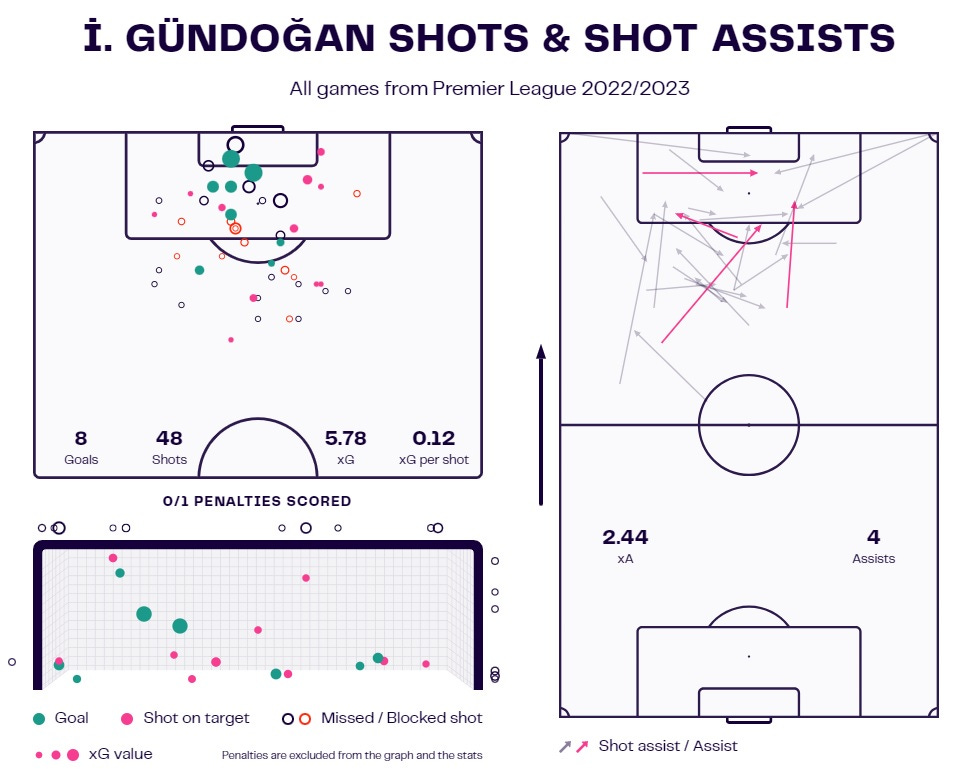
Looking at the placement and the shot locations too, we can see Gündoğan’s goals generally come from high expected goals areas, meaning he optimises his chance of scoring through great movement and positioning; it’s something forwards generally specialise in too. A similar thing can be said for the shot assists as well - most come from higher positions on the pitch. But this is something Pedri and De Jong, in particular, can replicate quite well.
Both are quite creative with the ball at their feet, contrary to popular belief, especially with the latter player, and they even eclipse Gündoğan’s contribution at Manchester City. There are, however, a few issues I still have with this whole premise of Gündoğan at left-wing/left interior, some relating to him individually and some being more of a collective problem. Let’s deal with the former first.
Subscribed
When it comes to on-the-ball ability, Gündoğan is more of a carrier than he is a passer. But even though he’s still proficient at it, it’s something that’s slowly getting less effective too. Yes, this impacts his progressive power but also his ability to create separations from defenders, giving himself better positions and angles to take a shot. In that sense, someone like Pedri would fare much better in the same scenarios. The ball remains glued to his feet and he carries and manipulates his body like almost no one in world football. There is scope for him to eclipse the new Barcelona arrival in all of these aspects scarily quickly.
But this is all a result of a slowly declining physical predisposition for the German; Gündoğan is 32 and not getting any younger so he doesn’t have the legs to cover a lot of ground or lead the press anymore.

He’s not a volume dueler nor does he always push high up the pitch to register dangerous recoveries. Similarly, he doesn’t crack the top 30 midfielders in successful defensive actions or duelling but also doesn’t register many fouls while doing so, suggesting efficiency and comfort with that lower volume. But the Gavi role requires running. A lot of it even. So if Xavi wants to reap the attacking benefits of having Gündoğan on the left, he will somehow have to compensate defensively.
This issue is even more highlighted when we factor in Oriol Romeu, the new arrival in the defensive midfielder position, who is also more proficient at defending space than man-marking. Everything points to Barcelona (finally) evolving off-the-ball in 2023/24.
However, this isn’t the only issue with this system. Let’s talk structures and personnel next.
(Potential) Issues with the box
The main problem for Barcelona in the box system is the width holder. As mentioned earlier, Xavi’s box differs from Pep’s and that difference will affect Gündoğan as well (or anyone in that left-winger/left interior role). So what is the difference, then? The difference is in how either team creates width and who and how provides it.
Grealish, a right-footed left-winger, usually started just outside of Gündoğan on the left at City while at Barça, that will likely be Balde, a left-footed left-back. The difference is in their starting position and reception of the ball.

This is an example of Manchester City’s box and the dynamic Gündoğan had with Grealish. The English winger is someone who is great in tight spaces, a retainer of the ball and someone who can combine well with the players around him. This makes his profile perfect for keeping the ball and linking up. But he is also a right-footed winger who starts high.
Notice how his high starting position affects the opposition’s defensive block; since there is a player immediately occupating the high and wide position, the full-back needs to prioritise stopping Grealish’s reception of the ball, freeing the half-space in the process. That means Gündoğan has more space to work with immediately. Another thing is the reception of the ball.
Grealish being a right-footer playing on the left also optimises his reception directly to his feet due to the angles. His body positioning when facing play is more suited to right-footed control and is therefore a tool for retention, not verticality. With Balde, it’s the exact opposite in almost every regard.
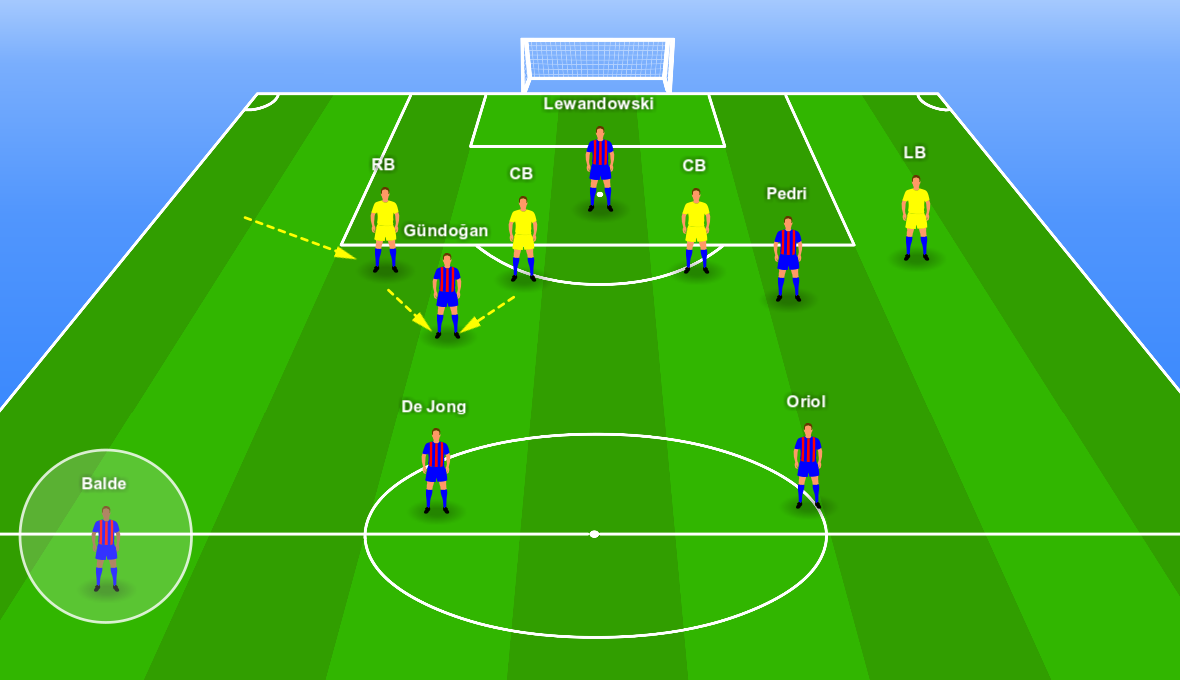
Balde is a powerful runner, carrier of the ball and attacker of space. He can exploit the area behind the opposition’s line and is a menace when running at the defenders. But he is also not an inside presence or a player of a highly combinatory nature. Additionally, he is a left-footer playing on the left who arrives high.
Now, notice how his low starting position affects the opposition’s defensive block compared to how Grealish’s high starting position does. Since Balde has to arrive high to occupy width, it gives the defenders the freedom to immediately congest the half-space, giving a receiver like Gündoğan less space to work with. More issues arise when we factor in his reception of the ball.
Balde being a left-footer playing on the left optimises passes in behind as opposed to directly to feet. The angles for reception to feet are awkward if a leftie faces the play. They’re not impossible but simply not optimal. And considering Balde’s less combinatory profile, the issues could be even more emphasised. This forces the passes to him to be primarily deployed into space, prioritising verticality, not retention. It is also here I have to mention Kannan Ahmed (@thewittyjack) who was kind enough to help me crystallise this train of thought. Give him a follow. Back to the topic at hand though, what are the solutions for Barcelona here?
Well, ideally they play with a winger who can hold the width, rather than the full-back doing so. The main reason is exactly the high starting position which creates more space for half-space receivers like Gündoğan, Pedri or Gavi. That means someone like Ansu Fati or Ferran Torres, while not exactly Grealish stylistically, would do a better job due to their natural profile and preferred foot. Abde is an option too but he is more of a Dembélé or Raphinha than a Grealish too so also not a retainer of the ball.
The other option is Balde as the left-winger in a 3-box-3 with a high position both on and off the ball. It is crucial the width-holder is present up high as much as possible to optimise for space creation between the lines horizontally. It also means he takes the defensive workload off of Gündoğan while Gündoğan compensates for the front three’s lack of output since Balde, Robert Lewandowski and Dembélé are creative but only have one true finisher among them.
Finally, we have to address how the box itself is going to interact. Assuming Xavi opts for the double pivot of De Jong and Oriol and the interior tandem of Gündoğan and Pedri, there’s a potential overlap here we have to address.
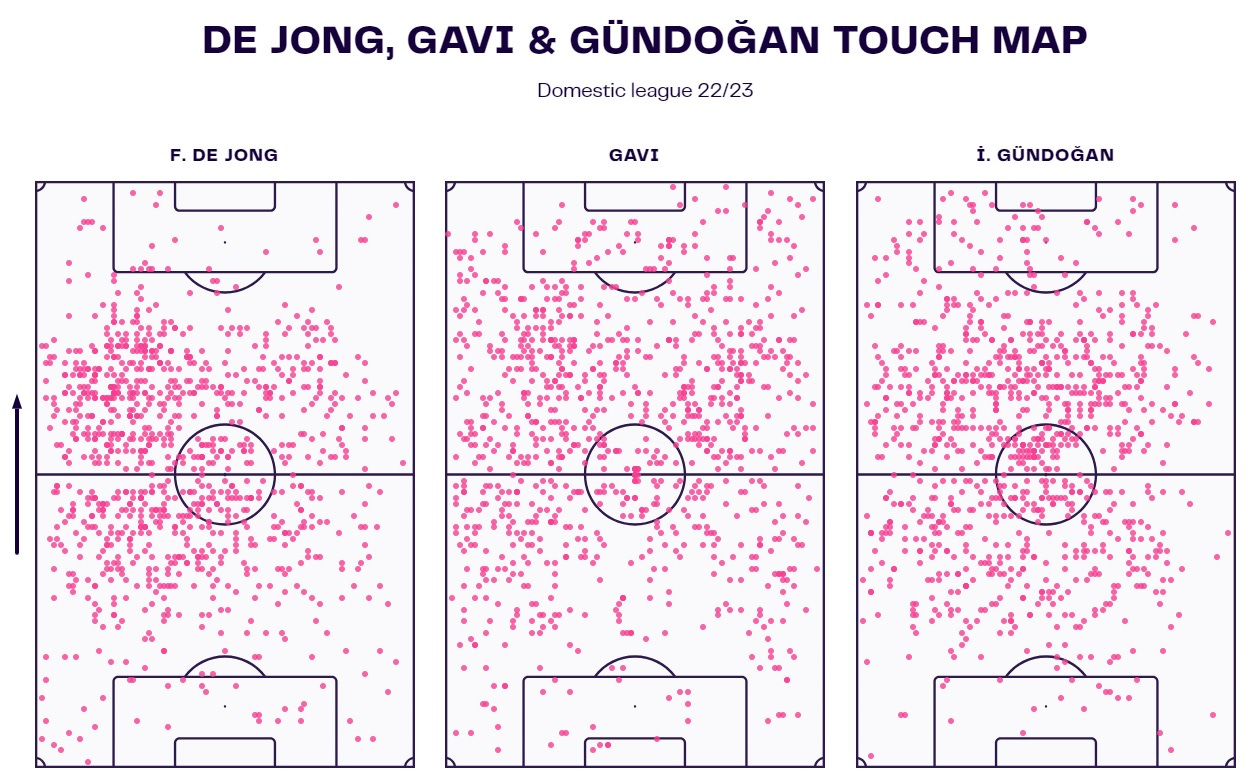
De Jong and Oriol are a great blend of vertical and horizontal but the former’s tendency to progress via carrying and not passing could get in the way of Gündoğan’s tendencies to drop deeper. The German is an excellent controller of the game and for Manchester City, his left interior role often saw him drop and even swap places with one of the pivots. This would see someone like Rodri or Stones push up while Gündoğan stays deeper and connects the thirds.
Something akin to this might happen with De Jong as well or rather, that would be the solution to the overlap problem. The Dutchman and the German are very similar players but the former is more accomplished in creative passing while the latter is more accomplished in finishing. Looking at their respective touch maps above, we can see how De Jong’s busiest area is just under Gavi’s busiest area, meaning they try not to overlap too much. This means the LDM and the LW/LCM can indeed coexist.
However, just as was the case with Gavi, this setup might limit Gündoğan and prevent any major build-up access for him, the same way it would likely do to Pedri. This is the main reason why I want Pedri on the right. There, he can be more involved across all the phases while the left highlights the pure attacking output.

When everything is said and done, this is what that lineup would look like in theory. It’s as optimal as can be but not perfect. Fati or Balde high up optimise the half-space ball reception and the latter also provides an off-the-ball engine. Gündoğan on the other hand helps with the attacking output but is then limited in his build-up involvement due to De Jong’s presence and the nature of the left interior role. However, the two can coexist and complement each other.
As the right interior, Pedri is given more responsibility in the first and second phases of the game while also being free to access the final third/the box simply because he is Pedri and he can do that. De Jong and Oriol are a good progressor and retention tandem while the backline offers a good balance of defensive know-how and on-the-ball ability.
Finally, Lewandowski and Dembélé are there as Xavi’s difference-makers. Their jobs remain unchanged.
Final remarks
Gündoğan’s natural quality and extensive profile shine everywhere and have an impact on everything. But the reality is, you can’t have your cake and eat it too. Barcelona will have to pick their poison and chip one part of their perfect midfielder away so the other can have maximum effect.
What will Xavi end up choosing? Does he put the German on the left to prioritise his attacking presence or does he ensure more control by sticking him on the right instead? The same goes for Pedri - where does the coach value the young prodigy’s presence more?
Only time will tell but one thing is for sure - as much as this is a sweet dilemma to have, not many would like to be in the gaffer’s shoes right about now. The positive is, both Gündoğan and Pedri are so good they will be effective either way. But it’s all about finding the best possible system for the whole team. And that’s easier said than done.
So good luck coach, and good luck İlkay.


